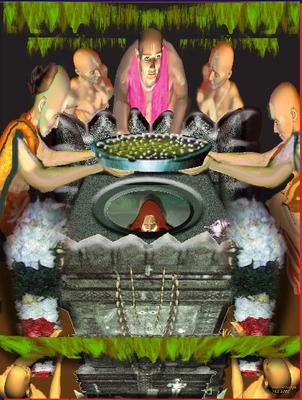Sri Shaligrama mahima
HARI SARVOTHAMA!! VAYOO
JEVOTHAMA!!
~~~~~~~~~~~~~~~~~ ~~~~~~~~~~~~~~~~~
MOOLA RAMO VIJAYATHE!!
GURURAJO VIJAYATHE!!
~~~~~~~~~~~~~~~~~~~~~~
~~~~~~~~~~~~~~~~~~~~

OM SRI RAGHAVENDRAYA NAMAHA!
****************************
The above picture dipicts the event of Raghavendra Swami being placed
into samdhi whilst still alive, along with his beloved Shaligrams
Message: 2
Date: Thu, 17 Feb 2005 13:14:40 +0530
From: "Sateesh" <sateeshg@hotmail.com>
Subject: FW: [IGR]: Shaligrama Mahima In English Part 1
Sent: Tuesday, February 08, 2005 11:22 AM
To: brindavan@gururaghavendra.com; articles@gururaghavendra.com; info@gururaghavendra1.org
Subject: [IGR]: Shaligrama Mahima In English Part 1
As many devotees requested for english version of shaligrama mahima
now we are publishing in english. Soon we also publish in kannada language.
Send your comments to webmaster@gururaghavendra.com (this was sent
via VMS Vishva Madhwa Sangha yahoo groups)
WONDERS OF THE SALIGRAVA PART 1
It is believed that GOD appeared the
very moment stone was formed. 'SARGARA', 'PASHANAM'. 'SILA', 'PRASRAM'
and 'SARGARA' all refer to rocks, pebbles and black mountainous stones.
The above words can be found in all the four VEDAS (holy scriptures ).
Of these, the word "GRAVA' appears in the RIG VEDA. Refer to the
mantra, "GRAVANA THUNTHO ABISHTOOTHAR". When combined with the word 'GRAVA',
it becomes 'SALISA ASOWGRAVASA' abbreviated as 'SALIGRAVA' or 'SALAGRAVAM'.
Various minerals, rocks, an alloy of metals, iron, glass and asbestos collect
in the crevices of rocks, mountainous streams, rivers and sand-beds where
they settle and stagnate. This process, in due course causes the formation
of Saligrava stones. As they are self-formed, these are known as 'suyambu
statues'. The factors that determine the quality of a saligrava are its
colour, brightness, well-rounded shape, impressions and wheels. These types
of stones can be found in very, very ancient river-beds too. These stones
possess inherent energies that render them worthy of worship as they have
been lying underneath the waters for a very long time, perhaps for thousands
of years and have been duly energized spiritually through constant prayer
and worship, upon their discovery, by our elders for generations. It is
a firm belief that the worship of the Saligrava alone can assure one of
salvation (moksha) and happiness (boham). I have written about the
glory of these stones, to the best of my knowledge for the benefit of the
believer, based on information extracted from the 'Garuda', 'Agni'
and the 'Vishnu' Puranas (legends) and on my own experience and research.
Saligravas can be categorized into several types. Some say there are 24,
48 and even 64 types. Let me refresh what I've learnt in the 46th chapter
of the 'Agni' Purana. Circles, lines and dots are generally found in these
stones. A Saligrava with a hollowed interior has circles in this region.
Such circles are absent in unacclimatised stones. It is said that the formation
of the circles are due to the burrowing of these stones by a particular
worm called the 'vajrathamshtra keedam' This, infact is true.
(to be continued)
TRANSLATED BY: SUSILA











